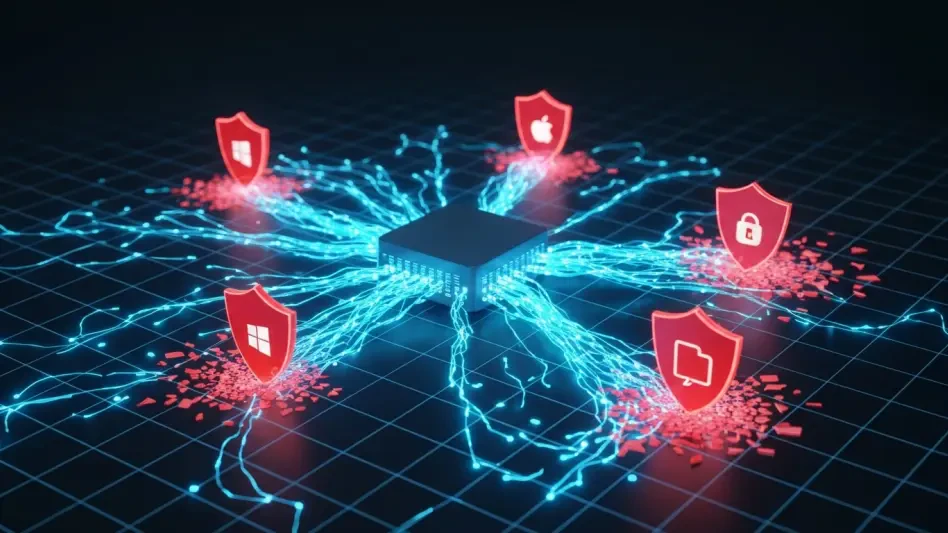In an era where hybrid work environments and sprawling digital ecosystems dominate enterprise landscapes, the challenge of securing access to critical resources has never been more pressing, especially as cyber threats evolve at an alarming pace. With traditional tools like VPNs and early zero trust network access solutions often falling short, organizations are left vulnerable to breaches and operational inefficiencies. Netskope has stepped into this arena with its Universal Zero Trust Network Access (UZTNA) solution, an integral part of the Netskope One platform, designed to address these gaps through a unified, scalable approach. By integrating advanced threat protection, context-aware device intelligence, and streamlined policy management, this innovative framework promises to transform secure access from a cumbersome barrier into a seamless enabler. This exploration delves into how Netskope is reshaping the security landscape, offering fast, consistent connectivity for users, devices, and private applications across diverse environments while minimizing reliance on outdated technologies.
Addressing Modern Enterprise Challenges
As enterprises navigate the complexities of remote workforces and diverse device ecosystems, the limitations of legacy security tools become glaringly apparent. Solutions like VPNs, Network Access Control (NAC), and Virtual Desktop Infrastructure (VDI) often struggle to scale with the speed and diversity of today’s hybrid environments, creating bottlenecks and exposing vulnerabilities. Netskope’s UZTNA emerges as a game-changer by providing a comprehensive framework that ensures secure access for both remote and local users, as well as IoT and OT devices. Built into the Netskope One platform, this solution integrates Private Access and Device Intelligence to deliver robust protection without compromising performance. By focusing on a unified approach, it reduces the complexity of managing multiple disjointed tools, allowing organizations to enforce consistent security policies across varied environments, ultimately enhancing operational efficiency and reducing risk exposure.
Another critical aspect of Netskope’s approach is its emphasis on adaptability to meet the unique demands of modern enterprises. The UZTNA solution tackles the challenge of securing private applications and east-west traffic through strategic integrations with third-party NAC vendors and built-in firewall capabilities for north-south traffic. This ensures granular zero trust policies are applied universally, safeguarding data and resources regardless of location or device type. Furthermore, the inclusion of advanced threat protection and data loss prevention (DLP) capabilities allows for thorough inspection of private application traffic, maintaining a high level of security for all interactions. Such a multifaceted strategy not only addresses immediate security concerns but also positions enterprises to handle future threats with confidence, marking a significant departure from the rigid, outdated methods that have long hindered progress in cybersecurity management.
Innovating with Advanced Features and Intelligence
A standout feature of Netskope’s UZTNA is its context-aware device intelligence, which extends zero trust principles to devices that cannot run agent software, such as IoT and OT systems. Leveraging the 5G Netskope One Gateway, this capability enables the discovery, classification, and management of device risks through tailored policies, ensuring comprehensive coverage across an organization’s digital footprint. This is particularly vital in environments where non-traditional devices are increasingly integral to operations, yet pose unique security challenges due to their inability to support conventional security measures. By embedding such intelligence into its framework, Netskope ensures that every endpoint, regardless of its nature, is subject to rigorous risk assessment and control, thereby fortifying the overall security posture of enterprises in a way that legacy solutions simply cannot match.
Beyond device intelligence, Netskope pushes the envelope with AI-driven policy optimization through its recently introduced Copilot feature, designed to simplify and accelerate the adoption of zero trust principles. This tool automates policy creation and auditing, significantly reducing the complexity and time associated with manual configurations, which often deter organizations from fully embracing advanced security models. Additionally, UZTNA enhances branch-level security by hosting the ZTNA publisher on the 5G Gateway, enabling secure access to private applications within branch networks while enforcing least-privilege access across IT, IoT, and OT environments. Such innovations underscore a commitment to balancing robust security with operational ease, providing enterprises with the tools needed to navigate the intricacies of modern cybersecurity without being bogged down by cumbersome processes or fragmented systems.
Transforming Security into an Enabler
Reflecting on Netskope’s contributions, it’s evident that the Universal Zero Trust Network Access solution marks a pivotal shift in how enterprises approach secure access. By weaving together device intelligence, advanced threat protection, and AI-powered management, Netskope has crafted a scalable alternative to outdated technologies that once hindered progress. This comprehensive toolset empowers organizations to maintain consistent protection and performance, whether users and devices are remote or on-site. The integration of diverse features into a single platform streamlines operations, cutting through the clutter of traditional security models. As enterprises look ahead, the focus shifts to leveraging such unified frameworks to stay agile against emerging threats, ensuring that secure access remains a cornerstone of efficiency rather than a constraint. Exploring scalable, innovative solutions becomes the next logical step for those committed to safeguarding their digital environments with precision and foresight.








